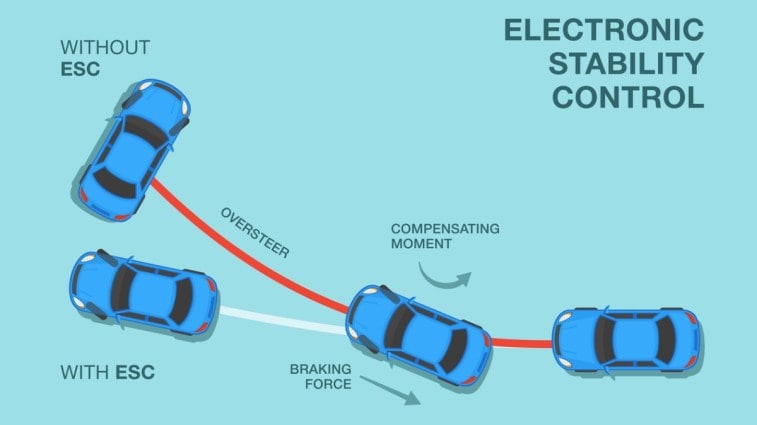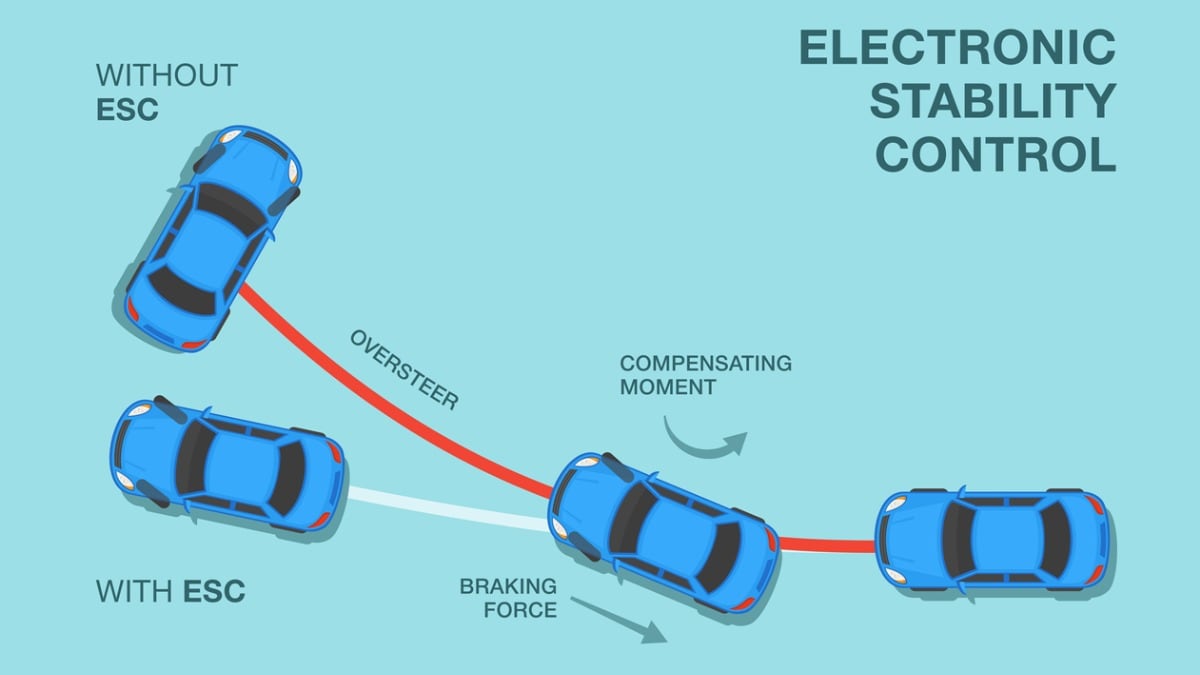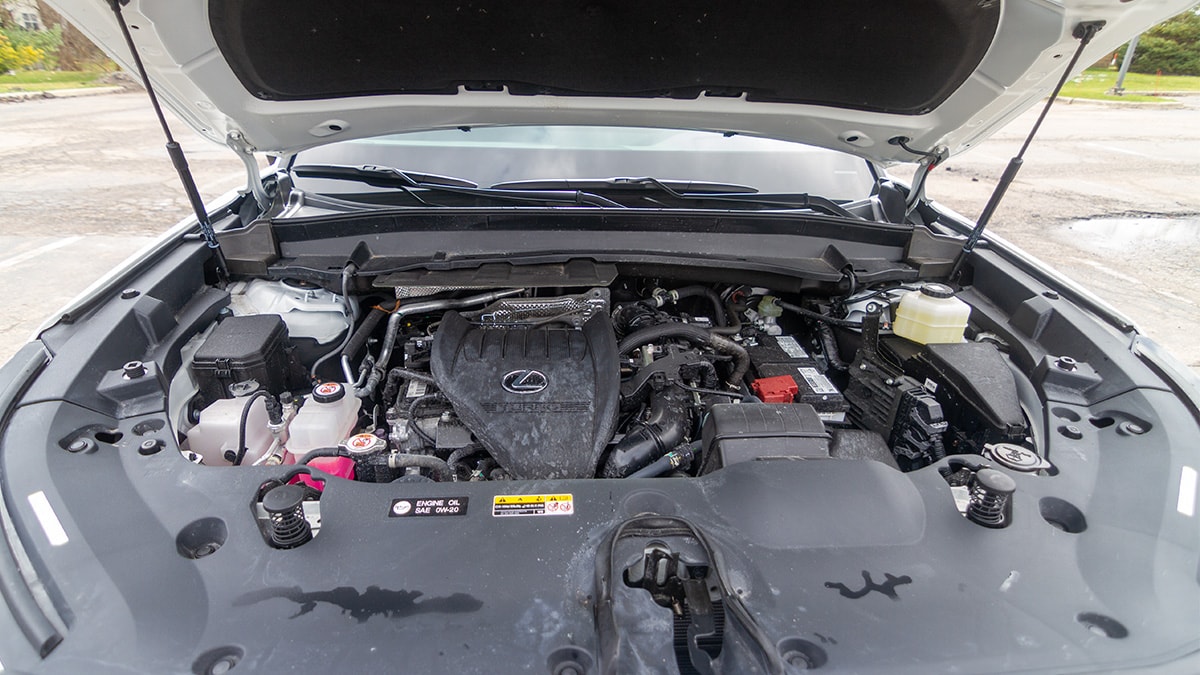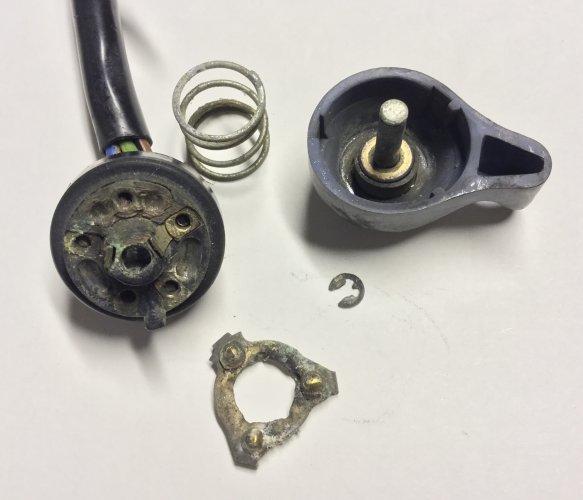

Quick Facts About Electronic Stability Control
- Electronic stability control systems help prevent cars from skidding when turning and drivers from losing control in critical driving situations.
- An ESC system evaluates data from various sensors and activates when it detects a loss of control, and then makes throttle and brake adjustments to bring the car back onto its path.
- A malfunctioning ESC system triggers a dashboard warning light. Take the car in for servicing if the light stays on.
Electronic stability control, or ESC, is an automatic system in your car designed to help keep you on course when steering. Continue reading to learn about ESC and how this automotive safety feature works to prevent accidents by helping your vehicle go in the direction you want it to go.
What Is Electronic Stability Control?
Electronic stability control systems use automatic computer-controlled braking of individual wheels to assist the driver with maintaining control of the car in critical driving situations. ESC helps prevent a vehicle from “spinning out” or “plowing out” due to the loss of road traction caused by slipping wheels.
The technology behind the ESC system is highly effective in assisting a driver in maintaining control of the car during hard-steering maneuvers. ESC does not explicitly prevent a vehicle from flipping over. Still, the safety feature helps keep the tires on the pavement, where a car is much less likely to roll over.
ESC is marketed using many names, including Vehicle Stability Control (VSC), Electronic Stability Program (ESP), Dynamic Stability Control (DSC), and several others.
When Is Electronic Stability Control Activated?


The electronic stability control system monitors your steering wheel input and helps ensure the car goes where you want it to go. ESC activates when it detects a probable loss of steering control.
When it recognizes that the car is not going where the driver is steering, the system makes adjustments to correct the car’s course or minimize skidding during emergency evasive swerves.
ESC also comes into play when drivers move the steering wheel too much (known as over-correcting) when attempting to control the vehicle in an emergency. Well-intentioned drivers sometimes understeer or oversteer during poorly judged turns. This can happen on slippery roads or when hydroplaning and is a leading cause of single-vehicle crashes.
How Does Electronic Stability Control Work?
Electronic stability control modulates the engine throttle and each wheel’s brake. Like other driver aids, ESC turns on when you start your car. The technology operates in the background, monitoring steering wheel activity and speed sensors on each wheel.
When sensors determine the driver is losing control, the ESC system engages automatically to adjust for oversteer and understeer. It applies or eases the brakes of each wheel on the car to bring the vehicle back onto the intended path. ESC involves the traction control systems, adjusts engine power to reduce speed, and applies brakes if the driver gives too much gas.
These manipulations can significantly reduce your risk of being in a rollover. They help keep the car on the road, where it is less likely to be “tripped” by something off the roadway and flip over.
- ESC increases brake pressure to one side of the vehicle to steer it gently in that direction. Results vary depending on whether and how much the front or rear brakes are applied.
- Electronic stability control does not apply hard braking or steering automatically.
- ESC estimates the direction of the skid. It asymmetrically applies the brakes to individual wheels to bring the car back in line with the driver’s commanded direction.
- The ESC system may reduce engine power or operate the transmission to slow the vehicle down.
How to Operate Electronic Stability Control


You don’t need to do anything to get your car’s ESC operating. It begins monitoring steering and speed when you start the engine.
ESC activates when it detects a driver losing control of the car. The system automatically adjusts individual wheel brakes to help stabilize the vehicle during a momentary loss of control. A warning light flashes on the dashboard when your ESC activates and makes adjustments. You may feel slight jerks and lurches as the system applies the brakes and reduces engine power.
Spin-outs can happen when drivers take turns too sharply and quickly. Reduce your speed when driving and be sure to take turns slowly and carefully. Computerized driver aids such as ESC can help in dangerous driving situations. ESC is not a substitute for responsible driving habits on slippery roads.
How Do You Turn Off Electronic Stability Control?
The ESC system is an important safety feature that automatically comes on to improve your car’s stability. Turning it off is dangerous. It is not advisable to intentionally deactivate a vehicle’s electronic stability control for normal driving situations. However, it may be desirable to allow more wheel spin when starting in deep snow, sand, or gravel, or when driving with snow chains. In most vehicles, you can temporarily turn off electronic stability control by pressing the “ESC off” button on the dashboard or center console. Once the need for ESC to be off is complete, press the button again to activate the control.
MORE: Power Steering Guide: Everything You Need to Know
Common Problems With Electronic Stability Control
Electronic stability control systems generally work effectively. However, the following issues can arise:
- Problems with your anti-lock braking system (ABS), such as worn brake linings and air or dirt in the brake fluid, can affect ESC operation.
- Tires with poor tread and those that aren’t in good condition can reduce ESC’s effectiveness. Read our tire guide to know more about them.
- A defective brake light switch can trigger the ESC light. This common problem is easily fixed with an inexpensive replacement switch.
- Steering input during high-performance driving may not always indicate the intended direction of travel. In these instances, ESC can intervene when it is unwanted.
Cost to Service ESC
As with most automotive electronics, the cost to repair a malfunctioning ESC system varies depending on various factors. Replacing a brake light switch is an inexpensive solution for one common problem. Other issues can be more difficult and costly. Some problems may be covered by the vehicle’s warranty.
Most reputable auto repair shops with the right tools can diagnose and service electronic stability control system issues. Estimating a price to correct problems here is difficult because of many variables. For example, the cost to replace a wheel speed sensor might cost $100 for one vehicle but $150 for another car. Depending on the vehicle, a replacement steering angle sensor can cost between $100 and $200 or more. On occasion, a software reset or update might fix a problem with your ESC. Labor rates can also vary by vehicle make and model, as well as your region.
Benefits of Electronic Stability Control
ESC systems use steering wheel position sensors to compare the wheel’s position to the vehicle’s actual steering response. If it detects something isn’t quite right, the ESC makes minor adjustments to the brakes or engine torque to help a driver maintain control.
An automobile’s ESC system provides many benefits:
- Counteracts vehicle skidding in slippery conditions
- Helps provide corrective support in critical driving situations
- Provides valuable assistive functions for driving safety, comfort, and agility
- Helps the driver maintain control of the car overall
MORE: Car Safety Features 101: Everything You Need to Know
What the Electronic Stability Control Light Means
Your car’s electronic stability control is a valuable safety feature. A malfunctioning ESC will stop working until any issues are fixed. An ESC indicator light illuminated on the vehicle’s dashboard can mean one of several things:
- Out of control. Electronic stability control is active and operating to maintain traction and direction because it senses the vehicle is not under control.
- Malfunction. The ESC system is malfunctioning or has been deactivated. You should promptly take the car to a qualified mechanic to correct the problem.
- Slippery conditions. An ESC dashboard light may indicate that driving conditions are slippery. You should slow down to improve your control.
Is It Safe to Drive With the ESC Light On?
You can drive your car if its electronic stability control light is showing on the dashboard but do so with extra caution. A steady ESC light may signal that the safety feature is malfunctioning.
Therefore, you must remember that you’re driving without the benefits of electronic stability control and have a greater risk of oversteering or understeering and spinning out of control. Reduce your speed, avoid hard braking, and keep off the road if it’s wet. We recommend you visit a qualified mechanic at a repair shop near you to fix the problem as soon as possible.
Things to Keep in Mind
- When the ESC light is off, your system is in ready mode.
- There is a direct relationship between your car’s ESC and its anti-lock braking system (ABS) and traction control system (TCS).
- The ESC system is most effective when the vehicle’s tires are properly inflated.
- Electronic stability control is standard equipment on newer cars. It became mandatory on all passenger vehicles starting with model year 2012. Some older vehicles, particularly premium brands, may have ESC included as an optional feature.
Read Related Articles on Car Safety:
Editor’s Note: This article has been updated since its initial publication.



